 Open Access
Open Access
ARTICLE
Textile UWB 5G Antenna for Human Blood Clot Measurement
Sri Chandrasekharendra Saraswati Viswa MahaVidyalaya, Kanchipuram, Tamilnadu, 631561, India
* Corresponding Author: K. Sugapriya. Email:
Intelligent Automation & Soft Computing 2023, 36(1), 803-818. https://doi.org/10.32604/iasc.2023.032163
Received 09 May 2022; Accepted 22 June 2022; Issue published 29 September 2022
Abstract
The antenna plays an essential role in the medical industry. The short-range 5th Generation (5G) communication can be used for seamless transmission, reception, patient monitoring, sensing and measuring various processes at high speeds. A passive Ultra Wide Band (UWB) antenna, used as a sensor in the measurement of Prothrombin Time (PT) i.e., blood clot is being proposed. The investigated micro-strip patch UWB antenna operating in the frequency range of 3.1 to 10.6 GHz consists of a circular patch with a diamond-shaped slot made of jeans substrate material with good sensing properties is accomplished by adjusting the copper thickness of the patch. Due to the turbidity in blood plasma, PT measurement is the repetitive approach to get accurate value. In order to solve this issue, an antenna is designed, fabricated and analysed to obtain the accurate PT measurements from blood plasma. The blood clotting is observed by electromagnetic emitted voltage converted into the frequency range of 5 to 10 GHz and voltage range of 0.66 to 0.87 mV. The circular UWB antenna is constructed employing jean’s substrate with a partial ground plane to improve the S-parameter, gain, bandwidth and performance characteristics. The proposed antenna with Specific Absorption Rate (SAR) value within the acceptable range can be used as a wearable device in the human body, leveraging 5G technology. This antenna is well suited for various other applications like wireless sensors, wearable devices and short-range communication applications.Keywords
An antenna acts as a transmitter and receiver in wireless communication 5G technology. Wireless communication technology is fast growing in today’s world. The size and frequency of events have a huge impact in meeting the needs of users at high-frequency applications. The experts and researchers are working on micro-strip and coplanar wave-guide-based designs in 5G. The passive antenna is utilized for sensors in medical as well as environmental applications like blood flow, level and time measurement. An antenna is a heart for 5G and wireless communication technology. In our day to day life, processes in a real-time environment, the scientific, industrial and medical applications are very important to user’s need. An antenna function is similar to a transducer in that it changes one form of energy into another form and allows electromagnetic energy to be transferred via a wireless channel. The UWB antenna provides the required bandwidth, gain and other antenna properties during the entire band range of 3.1 to 10.6 GHz. The patch antenna being smaller in size, low-power, easy to use and compatible with the wearable process and hence UWB antenna is most commonly used for short-range 5G communication. The microstrip patch antenna consists of a substrate with a rectangular or circular patch on the front side and a ground plane on the back side that may be a complete ground or partial ground plane. There is a fringing field created near the patch, i.e., electromagnetic field and the excitation of the input produces electromagnetic wave to transfer the information. Chen [1] designed an antenna of equilateral type with tunable stub consisting of a triangular shaped ring slot antenna fed by Coplanar Waveguide (CPW) feed. By changing the width and length of the design, it produces two resonant frequencies that lie in the frequency tunable ratio of 1.1–1.42. Tripati et al. [2] investigated Multiple Input and Multiple Output (MIMO) with a fractal antenna used for ON-Body applications and the antenna dimension is 25 mm × 25 mm. The performance of the design was analysed by considering the air medium and the human body parts near the forehead, chest and abdomen. Klemn et al. [3] investigated directional antenna with reduced size for Wireless Personal Area Network (WPAN) and Wireless Body Area Network (WBAN) applications. The antenna parameters in the proximity of the human body along with its radiation characteristics were discussed. Fujii et al. [4] introduced the analysis of the human body using Finite Difference Time Domain (FDTD) and the 2-pole Debye model is applied for 50 individual human tissues, operating in the frequency range of 100 MHz to 6 GHz. See et al. [5] investigated the experimental study of the UWB antenna with a working frequency band of 3.5 to 4.5 GHz with a −10 dB reference line and used for WBAN applications. The Radio Frequency (RF) link consistency was tested on a human body nearness system and reduction of power by properly selecting the receiver, transmitter antennas and mainly the reliability of an antenna over the 5G communication system. A compact tri-band monopole design was introduced by Deng et al. [6] for WBAN applications. The shape of the antenna is a miniascape strip which comprises of three different strips such as S, U, I and covers frequency bands 3.1 to 3.4 GHz, 4.2 to 4.9 GHz and 6 to 10.6 GHz respectively. The antenna performance is analyzed on the human body and the size of the design is 23.6 mm × 35 mm. Keong et al. [7] investigated the ultra-wideband body sensors in the transmission side for collision analysis. Here, complete attention was given to examining the simulation model for the collision between the data while transmitting through an antenna. Mahmood et al. [8] investigated the UWB antenna for WBAN applications with on and off on human body proximity. Halder et al. [9] discussed the optical wireless communication system through biological tissues, transmitted via practically implanted devices. For optical channel design, the pork meat is used to transmit via biological tissues over several centimetre distance and the measurement results were compared for both UWB and optical communication. A printed miniaturized UWB antenna was invented by Sharma et al. [10] for Internet of Things (IoT) applications, device-to-device applications and microwave imaging sensing applications. This microstrip antenna has U-shaped resonator slots located on the radiating patch with two Split Ring Resonator (SRR). The bandwidth is 7 GHz and the frequency ranges from 3 to 10 GHz having good radiation efficiency of 80%. Kassim et al. [11] discussed the 5G antenna operating from 10.125 to 10.225 GHz. Further, the shape of the antenna is extended with an Artificial Magnetic Conductor (AMC) as a meta-surface with a Coplanar waveguide (CPW) feed for improvement of bandwidth. Kissi et al. [12] invented cavity based antenna for bio-medical applications, wireless capsule endoscopy and operating frequency is 3.75 to 4.25 GHz.The antenna investigation has been carried out with and without cavity. For a maximum SAR of 0.112 W/kg at 4 mm antenna skin distance was measured. The gain is 6 dBi for without cavity model at 4 GHz resonant frequency. Arora et al. [13] investigated the antenna to determine the best location of human body proximity for energy efficient WBAN, which is used in real-time applications like sports, health care, entertainment and military. All antenna parameters are analysed, measured and compared with investigation of different node portions for WBAN applications. Kallur et al. [14] discussed triangular-shaped patch antenna fed by CPW, their dimension is 50 mm × 50 mm × 1.6 mm and resonant frequencies are 2.5 and 5.2 GHz. Further extended to wearable applications using polyamide substrate and the frequencies generated are 2.5 GHz S-band, 5.2 GHz Worldwide Interoperability for Microwave Access (WiMAX) and 7.3 GHz C-band. Pandimadevi et al. [15] investigated a flexible antenna for WiMAX applications. Foam substrate is used in this design and operates at a frequency of 3.5 GHz. This design is bendable, low-cost, wearable, small size, good directivity and wide bandwidth. The return loss is −24.95 dB, the gain is 3.096 dB, the directivity of the design is 4.93 dBi and the size of the design is 50 mm × 36 mm × 2.2 mm. Priya et al. [16] invented a compact monopole antenna for UWB applications and consists of a heptagonal patch loaded with a diamond-shaped slot and attached with two T-stubs. This antenna covers the applications like Wireless Local Area Network (WLAN) such as 5.18 to 5.85 GHz, WiMAX such as 3.4 to 3.69 GHz, radar applications such as 9.5 to 10.5 GHz, remote sensing and tracking applications such as 10.6 to 10.75 GHz. Vijay et al. [17] introduced an elliptical rectangular patch and defected ground was introduced for bandwidth enhancement, the operating frequency range is 2.5 to 15 GHz. Two elliptical-shaped Concentric Complimentary SRR slots are introduced in the patch for tri-band notch characteristics those frequencies are 3.3 to 3.7 GHz WiMAX, 3.8 to 4.2 GHz downlink C-band and 5.2 to 5.8 GHz in WLAN. A novel Meta structure wearable antenna is introduced by Ramanpreet et al. [18] for WBAN devices and is integrated with two designs. The microstrip patch is introduced in the upper layer and the lower layer shape is a Meta structure. The size of the design is 0.42
Problem Statement
The continuous monitoring of PT plays a vital role in the prevention of cardiac problem, to avoid the adverse drug effect and to analyze the prognosis of cardiac problems. For monitoring of PT from the human body, an efficient sensor and software tool is required. Moreover, continuous monitoring of PT bridges the gap between the food intakes. However, traditional methods such as coagulation analyzer could not monitor the PT continuously. Hence this research paper proposes a new antenna to monitor PT continuously. This proposed antenna also acts as an efficient sensor with high accuracy and reliability.
Contribution
The antenna as a sensor, measure PT based on the dielectric property of blood and is fixed over the human body for a continuous monitoring. The proposed 5G UWB antenna design predicts the Prothrombin Time more accurately from the blood sample. The proposed UWB antenna is located on the human body to monitor continuous measurement of PT and effortlessly transmit and receive signals through the same wearable antenna or on-body. This proposed antenna provides a better result in WBAN and 5G systems.
The various antenna design and findings related to the proposed method is specified in the Tab. 1. This shows the importance of PT measurement essential for the medical environment.

According to the literature, the 5G communication technology is used for high speed data transmission with the connection capacity of billion devices having a speed of 10 GB per second. The passive UWB antenna with a microstrip feeding method is employed in this design. The dimension of the proposed antenna is determined using the microstrip patch antenna design equations.
Width of the Patch
Effective dielectric constant
Effective patch length
Final patch length of the ground plane
Mobile phones and tablets are examples of portable devices that play an important role in human existence. In real-time scenario, the technology advanced at a rapid stage such as device size, visibility shortened and wearable devices. Sensors can be utilized to govern human activities in the future, and gadgets can be used to monitor various human requirements, including medical issues. The prothrombin time (PT) is defined as a blood clotting time which is a measurement of how rapidly blood clots. Traditional automatic and visual instruments available for measuring prothrombin time has a limitation that the inability to discriminate the clot formation graph, a long interval phase, tiny clotting durations, and the possibility that little friable clots have not defected. Fig. 1 shows the 5G Antenna design and PT measurement block diagram.
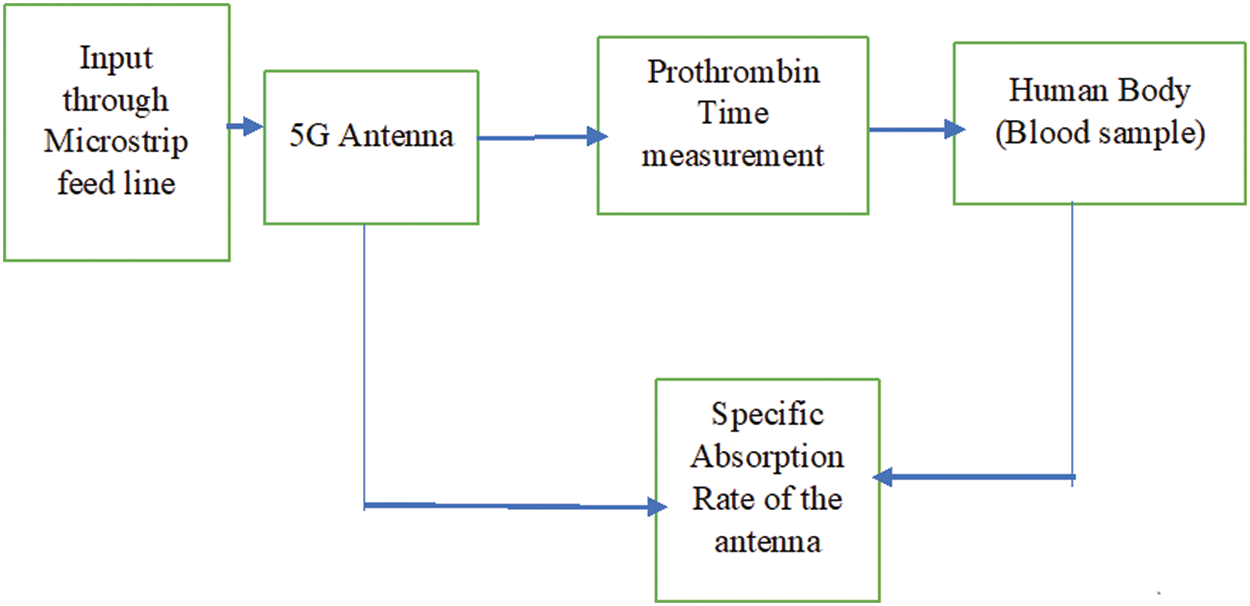
Figure 1: 5G Antenna design and PT measurement block diagram
A 4 ml BD Vacutainer test tube with a diameter of 13 × 75 mm and a capacity of 2 ml of blood was used to test the planned UWB antenna-based PT measurement. The plasma is separated from the blood sample by adding 1 ml of Ethylene Di-amine Tetra Acetic Acid (EDTA) solution to the sample and the PT is calculated using a passive UWB antenna mounted on the test tube face, based on the detected electromagnetic radiations. The concentration of particles in the plasma can vary depending on the conditions. The UWB passive antenna sensor can absorb radiations. Normal microstrip-based antennas are not suited for wearable applications and the structure must be designed according to a specific technique as represented in Fig. 2, which consists of four layers: air, skin, fat, and muscle.

Figure 2: Human phantom model
In the proposed work as a wearable antenna, the designed antenna is positioned on top of all layers. Tab. 2 represents the characteristics of human body tissues, including loss of tangent, permeability, and permittivity.

Based on the specifications given in Tab. 2., the proposed antenna is designed, simulated and fabricated using the jean’s substrate material. It is also proposed to achieve good wearable characteristics that are suitable for 5G communication. The different UWB antenna sensor investigations are given in the literature examination, which shows that the sensing characteristics are obtained using a passive UWB antenna in various Industrial, Scientific and Medical (ISM) band applications. The optimized dimension of the proposed antenna design is tabulated in Tab. 3. The proposed antenna simulated using High-Frequency Structural Simulator (HFSS) software.

The structure of the circular patch antenna (front and back view) is represented in Figs. 3 and 4, the antenna investigated for sensor application in PT measurement from blood plasma has been proposed using the jean as a substrate having a thickness of 1 mm, with the dielectric constant of 1.7 and loss tangent 0.025. Front view and the back view of the proposed antenna are shown in Figs. 3 and 4 respectively. The front view includes a circular shaped patch with diamond shaped slot. The proposed antenna is fed by a microstrip feed line to get good impedance matching and improved input excitation through the complete patch. The bottom observation indicated in Fig. 4 consists of a partial ground plane to achieve the necessary antenna parameter.

Figure 3: Patch front view

Figure 4: Patch back view
The Tab. 3 represents the parameters used for design and the size of the antenna is 60 mm × 60 mm × 1.6 mm. The dielectric constant is 1.7 with a thickness of 1 mm and a Loss tangent value of 0.025 chosen for the design. To investigate antenna parameters for 5G communication and wearable, the circular UWB antenna design was simulated using the HFSS software. The fabricated prototype is shown in Fig. 5 and the measurement proofs are represented in Fig. 6.
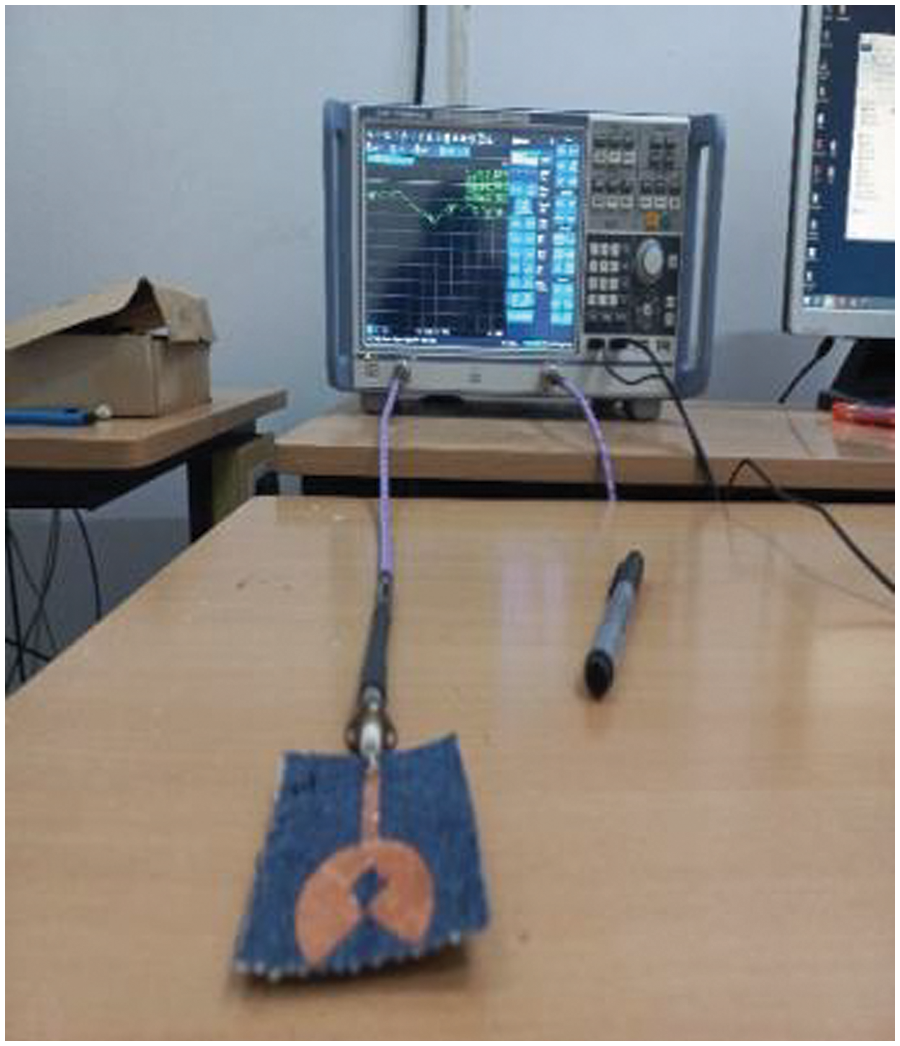
Figure 5: Fabricated prototype
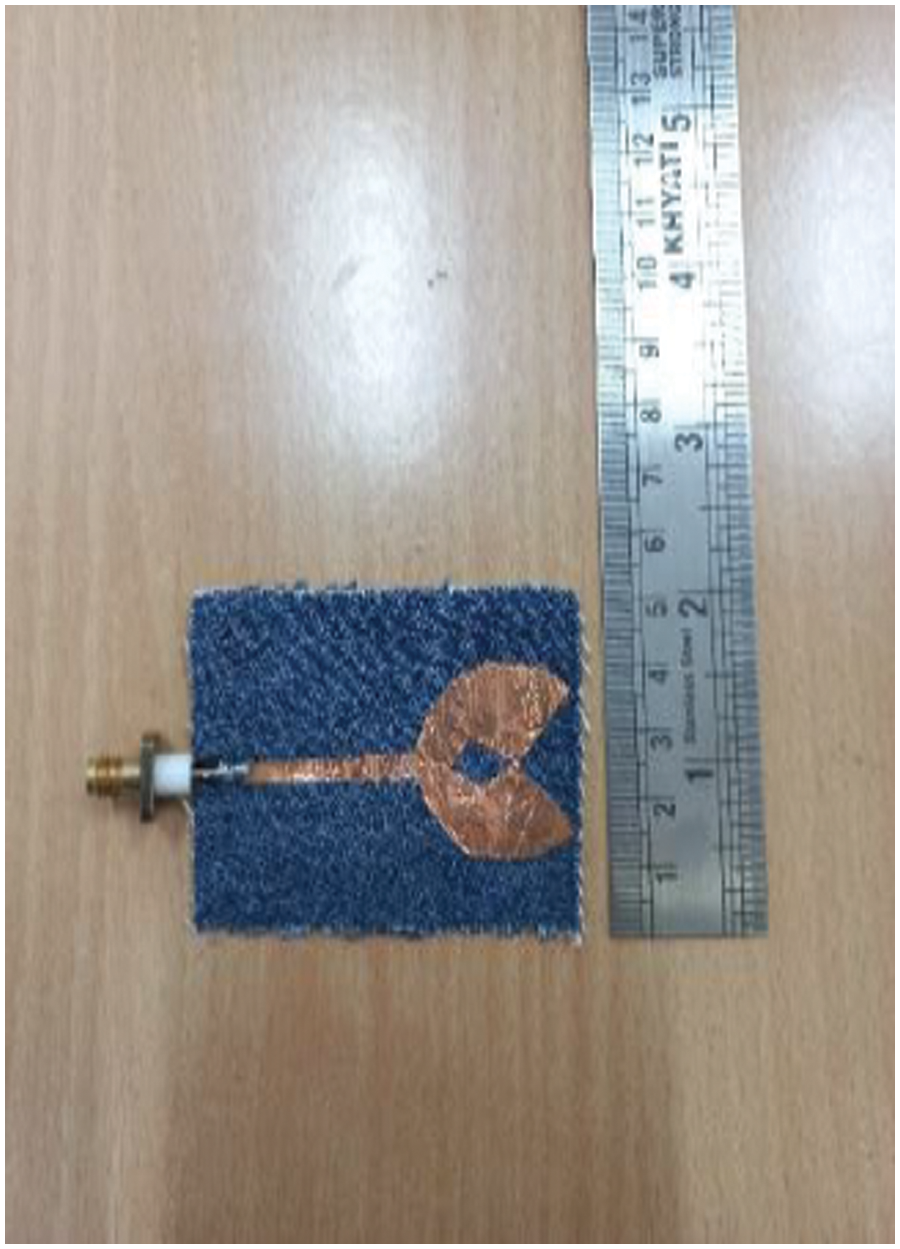
Figure 6: Fabricated result measurement
2.2 Methodology and Measurement
A passive UWB antenna is connected to the surface of the test tube to measure blood PT in the blood plasma. Collecting a sample of blood, plasma separation, signal acquisition from the plasma via a test tube surface located UWB antenna, removing the object from antenna signals like turbidity (lipemia) & vitamin, and machine learning processing of the object removed signal for PT measurement is obtained. The succeeding procedure eliminates the limitations of standard clotting tests, such as delay, and lack of precision due to the absence of vitamin elimination and turbidity. However, compared to previous procedures, in this method 2 ml of blood is composed in a red-capped BD Vacutainer serum which is quite easy and takes short time to measure PT. The First method is the Plasma separation test tube and plasma is separated from the blood after 4 microlitres of EDTA solution is added. The silica is used to trigger input and it is sprayed on the test tube's inner wall with blood. In the blood, the EDTA solution acts as an anticoagulant. The test tube with blood and EDTA solution is gently inverted to 180 degrees and then posterior 5–6 times. For the blood fractional process, the test tube is left idle for 10–15 min, during which time erythrocytes sink at the bottom and plasma forms above the erythrocytes. The section of plasma is sensed using the UWB antenna for assembly of electromagnetic radiations and to measure PT after the plasma and erythrocytes have been separated. The second method is a mathematical model; it can be used to look into the formation of fibrin clots in quiescent plasma. The amount of fibrin in the blood determines the porosity of the clot. The Navier-Stokes equation is used to describe the viscous fluid's motion because plasma is an incompressible fluid. During clot growth, the concentration denoted as Fi of any blood-clotting agent.
The proposed passive UWB sensor antenna is simulated using HFSS software. Fig. 7 indicates that the Reflection coefficient in dB (s-parameter) S11 of the design and occupies the bandwidth of 13 GHz (i.e., from 9.1 to 25 GHz frequency range) with S11 = −10 dB reference line the wider bandwidth is achieved with the patch conductivity obtained from the thickness of 1.06 mm. The resonance frequencies obtained are 17.5 21.5 and 26 GHz. S-parameter S11 can be represented in Fig. 8. It shows the good wide bandwidth obtained from 9 to 26 GHz by varying the patch thickness by 0.6 mm to encounter the sensing characteristics and operating bandwidth to measure the PT accurately with less time duration. The reflection coefficient of this antenna is fitted to the wireless sensor in the 5G communication system and WBAN applications. The proposed antenna resonates at wideband frequencies respectively and their S11 values are 20 −27 and −30 dB.
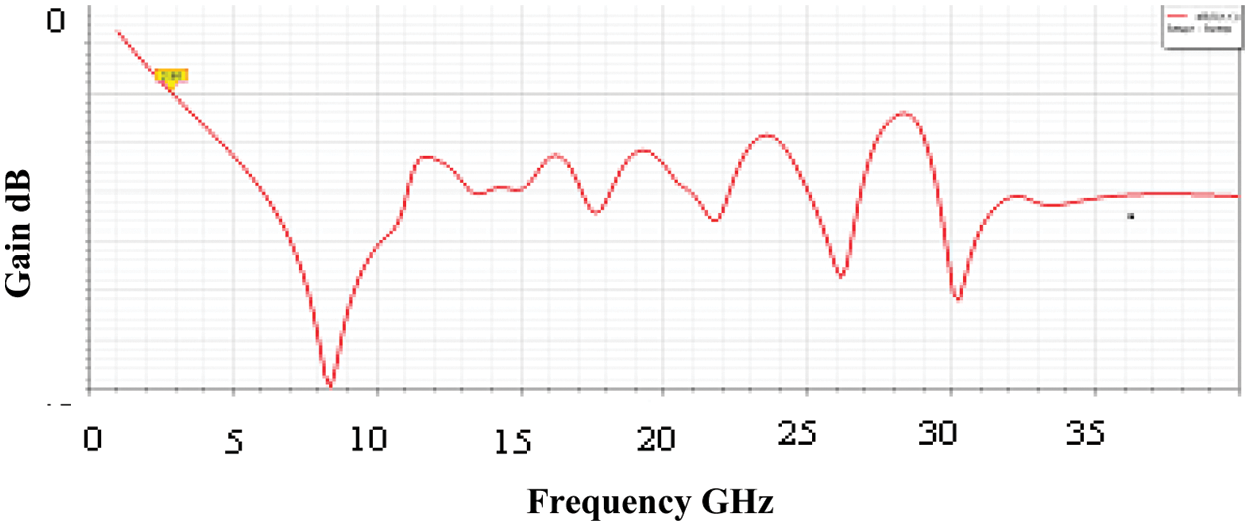
Figure 7: Reflection coefficient (dB)
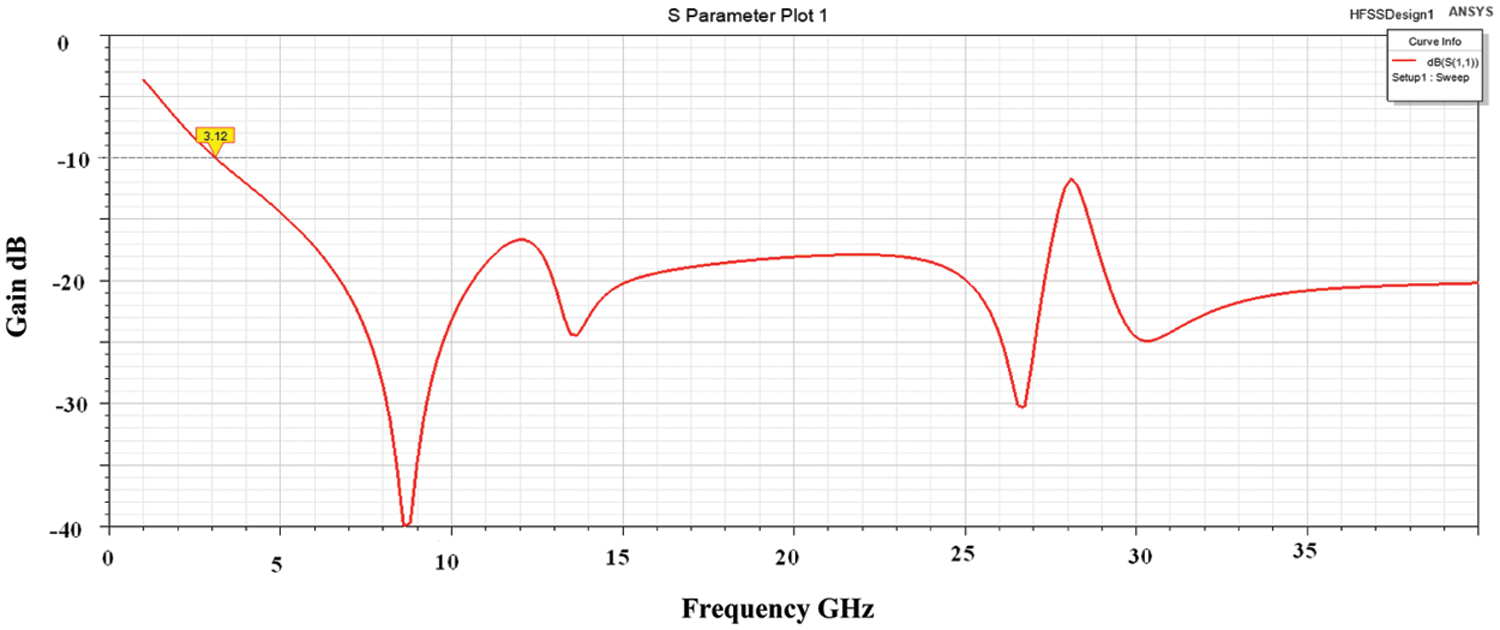
Figure 8: Reflection coefficient (dB)
Fig. 9 represents the proposed design voltage standing wave ratio value below 2. According to the measurement at wideband frequency range the antenna gives the desired value suitable for the sensor in a medical environment and the results of various antenna parameters suitable for WBAN were discussed.
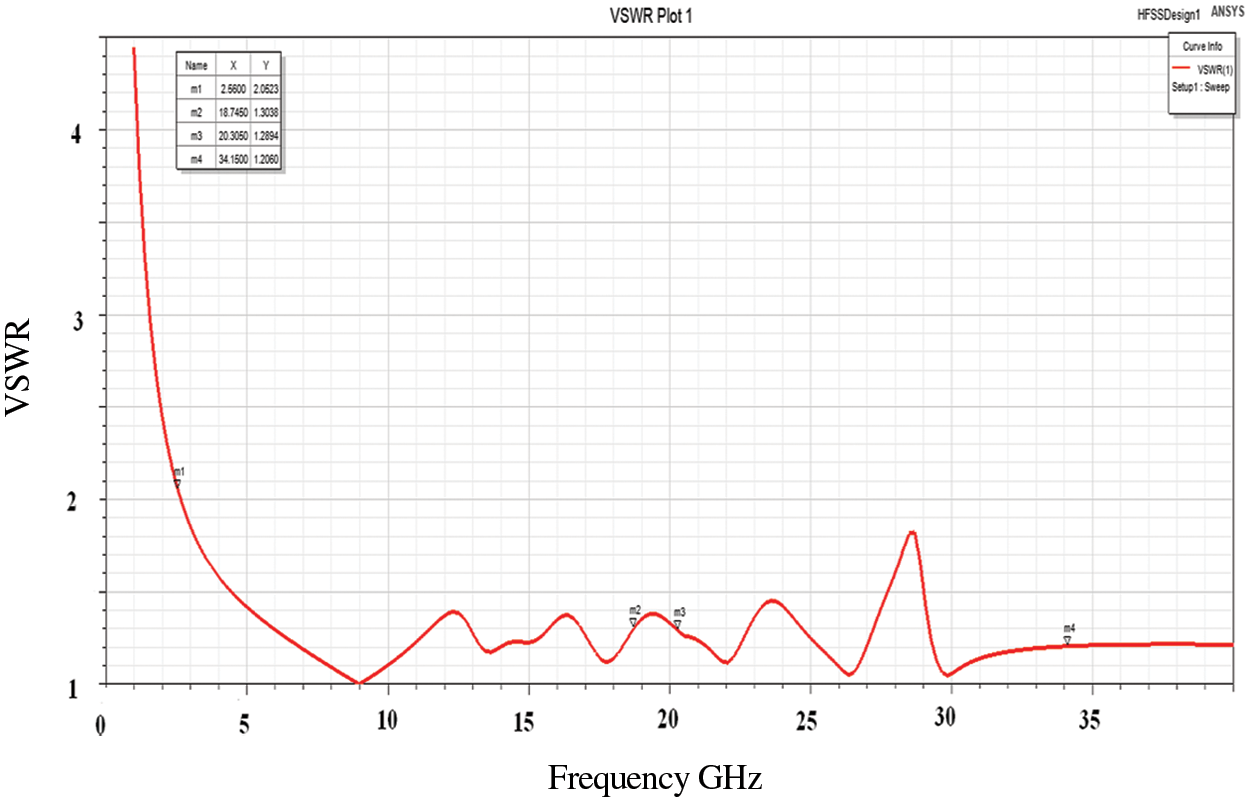
Figure 9: VSWR measurement
The UWB antenna is designed for PT measurement and it is fabricated using textile substrate material for the wearable process. The experimental results were analyzed in Vector Network Analyzer (VNA). Fig. 10 represents the experimental values of the design and it indicates that the simulated and fabricated results are same as indicated in the graphs.

Figure 10: Fabricated antenna reflection coefficient (dB)
The radiation pattern of the proposed design was measured in an anechoic chamber shown in Fig. 11 and the pattern was measured for various frequency values during the UWB range. The VNA measurement of the design is represented in Fig. 12. Hence, the proposed method and design accomplish the working coverage area for electromagnetic radiation of UWB an antenna. The radiation of a passive antenna measured for every 2 GHz in the UWB range to satisfy the required band of operation is represented in Figs. 13–15.
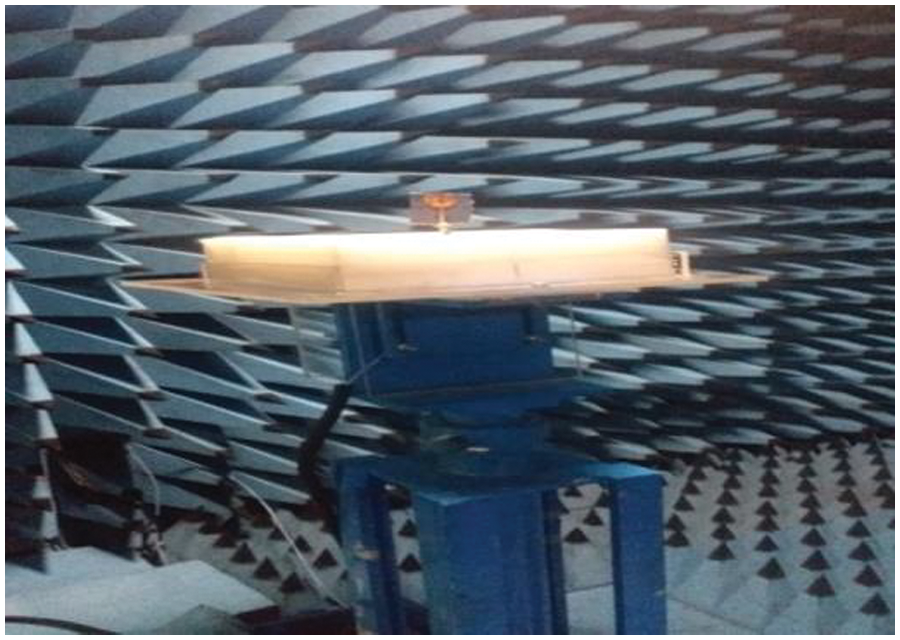
Figure 11: Radiation pattern
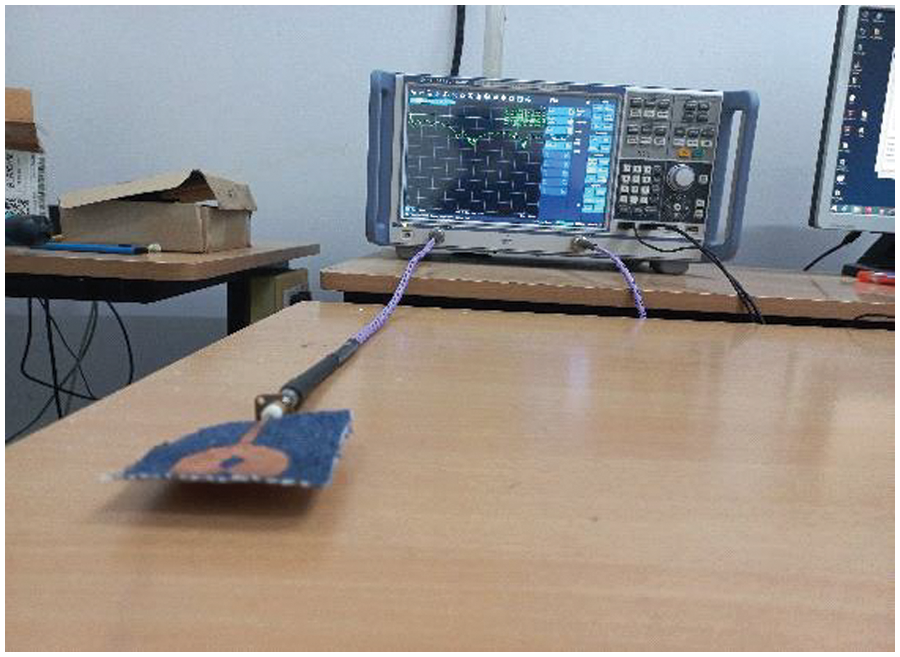
Figure 12: VNA connection
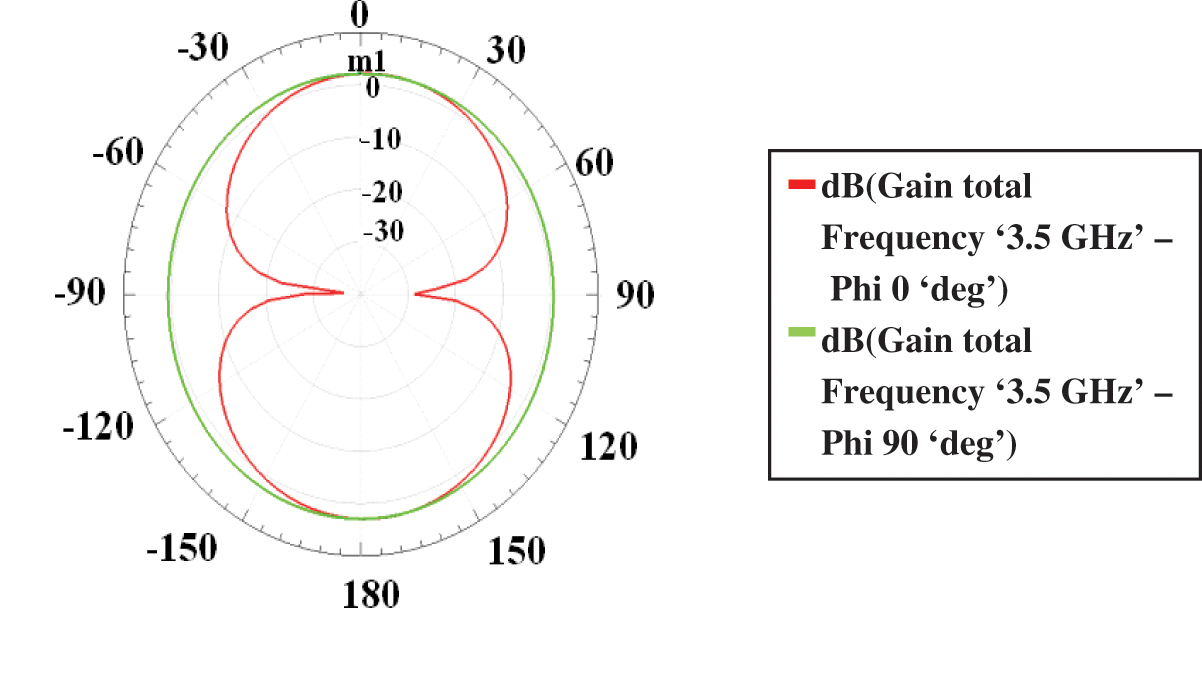
Figure 13: Radiation pattern 1
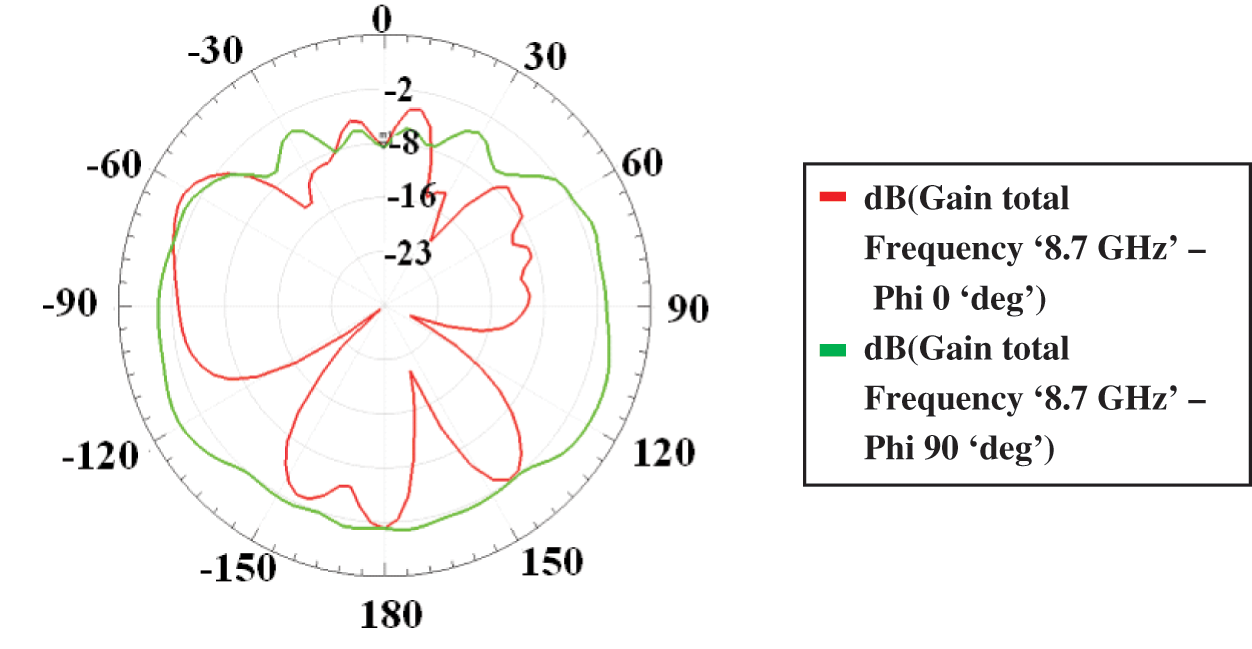
Figure 14: Radiation pattern 2

Figure 15: Radiation pattern 3
It shows the good gain values for the operation range. The SAR value of the antenna was determined using the human phantom model and it is measured to avoid the unnecessary loss of a human body. From the measured results the SAR value of the present design is below 2 W. The frequency measurement of the antenna signal for the corresponding blood components is represented in Tab. 4.The measured values are in the satisfied range and it will not affect the human body.

The proposed antenna absorbs the radiation from blood by applying an EDTA solution, the signal and data were acquired from blood plasma and it is separated from the blood. The Separated Plasma consists of artefacts induced by plasma turbidity (lipemia) as well as vitamin artefacts. First, the artefacts are removed using the blind source method of separation, since the plasma contains a considerable amount of turbidity, Vitamins and other minerals. Tab. 5 shows the comparison of simulated and measured results.

The antenna parameters are represented in the Tab. 5. According to the design, analysis, measurement and results obtained, the proposed antenna is suitable for 5G wireless sensing in the medical field and also used for wireless body area networks.
The proposed circular-shaped diamond slot 5G UWB microstrip patch antenna is designed for the measurement of PT from blood plasma. The antenna was designed, simulated, fabricated and antenna parameters were analyzed for PT measurement. The designed antenna has been implemented for obtaining accurate value of prothrombin time from blood plasma. The proposed UWB antenna’s patch thickness is varied from 0.6 mm to 1.06 mm. For 1.06 mm patch thickness, better sensing characteristics are obtained during wider bandwidth. Patch thickness of 0.6 mm provides very good ultra-wideband and good sensing performance. From the result analysis of the proposed antenna the resonance frequency is achieved in the UWB range, return loss −31.5 dB, gain of around 2 dB, Voltage Standing Wave Ratio (VSWR) of 1.05 and SAR value below 2 W is observed. This antenna also operates from 2 to 14 GHz which results in increased bandwidth. Hence, the design is suitable for 5G communication and UWB sensing applications in a medical environment. In the medical field, this proposed UWB 5G antenna can be used for continuous monitoring of patient blood flow-level and pressure is an added advantage. In future, sixth generation 6G antenna can be tested for PT measurement.
Acknowledgement: The authors would like to express her gratitude to for Sri Chandrasekharendra Saraswati Viswa MahaVidyalaya, Kanchipuram, providing administrative and technical support.
Funding Statement: The authors received no specific funding for this study.
Conflicts of Interest: The authors declare that they have no conflicts of interest to report regarding the present study.
References
1. J. S. Chen, “Studies of cpw-fed equilateral triangular-ring slot antennas and triangular-ring slot coupled patch antennas,” IEEE Transactions on Antennas and Propagation, vol. 53, no. 7, pp. 228–2211, 2005. [Google Scholar]
2. S. Tripathi, A. Mohan and S. Yadav, “Performance study of a fractal UWB MIMO antenna for on-body WBAN applications,” Analog Integrated Circuits and Signal Processing, vol. 54, no. 8, pp. 249–258, 2018. [Google Scholar]
3. M. Klemm, I. Z. Kovcs, G. F. Pedersen and G. Troster, “Novel small-size directional antenna for UWB WBAN/WPAN applications,” IEEE Transactions on Antennas and Propagation, vol. 52, no. 2, pp. 3884–3896, 2018. [Google Scholar]
4. M. Fujii, R. Fujii, R. Yotsuki, T. Wuren, T. Takai et al., “Exploration of whole human body and UWB radiation interaction by efficient and accurate two-Debye-pole tissue models,” IEEE Transactions on Antennas and Propagation, vol. 58, no. 2, pp. 515–524, 2009. [Google Scholar]
5. T. S. See, T. M. Chiam, M. C. Ho and M. R. Yuce, “Experimental study on the dependence of antenna type and polarization on the link reliability in on-body UWB systems,” IEEE Transactions on Antennas and Propagation, vol. 60, no. 11, pp. 5373–5380, 2012. [Google Scholar]
6. C. P. Deng, X. Y. Liu, Z. K. Zhang and M. M. Tentzeris, “A miniascape-like triple-band monopole antenna for WBAN applications,” IEEE Antennas and Wireless Propagation Letters, vol. 11, no. 1, pp. 1330–1333, 2012. [Google Scholar]
7. H. C. Keong, K. M. S. Thotahewa and M. R. Yuce, “Transmit-only ultra-wideband body sensors and collision analysis,” IEEE Sensors Journal, vol. 13, no. 5, pp. 1949–1958, 2013. [Google Scholar]
8. S. N. Mahmood, A. J. Ishak, A. Ismail, A. C. Soh, Z. Zakaria et al., “On-off body ultra-wideband antenna for wireless body area networks: A review,” IEEE Access, vol. 8, no. 9, pp. 150844–150863, 2020. [Google Scholar]
9. S. Halder, M. Särestöniemi, I. Ahmed and M. Katz, “Providing connectivity to implanted electronics devices: experimental results on optical communications over biological tissues with comparisons against ultra-wideband antenna,” in EAI Int. Conf. on Body Area Networks, USA, 3, pp. 3–17, 2020. [Google Scholar]
10. A. Sharma, P. Agrawal, N. Mishra, S. K. Sinha and M. S. Raut, “A miniaturized printed UWB antenna with sextuple stop bands based on U-shaped slot resonators and split,” Optical and Wireless Technologies: Proceedings of OWT, vol. 12, no. 4, pp. 253–263, 2020. [Google Scholar]
11. S. Kassim, H. A. Rahim, M. Abdulmalek, R. B. Ahmad, M. H. Jamaluddin et al., “UWB antenna with artificial magnetic conductor for 5G applications,” Innovations in Electronics and Communication Engineering, vol. 56, no. 3, pp. 239–250, 2020. [Google Scholar]
12. C. Kissi, M. Särestöniemi, T. Kumpuniemi, M. Sonkki, S. Myllymäki et al., “On-body cavity-backed low-UWB antenna for capsule localization,” International Journal of Wireless Information Networks, vol. 27, no. 1, pp. 30–44, 2020. [Google Scholar]
13. N. Arora, S. H. Gupta and B. Kumar, “An approach to investigate the best location for the central node placement for energy-efficient WBAN,” Journal of Ambient Intelligence and Humanized-Computing, vol. 1, no. 12, pp. 1–12, 2020. [Google Scholar]
14. R. S. Kallur and S. I. Rosaline, “CPW fed slotted triangular patch antenna for WLAN applications,” in Advances in Electrical and Computer Technologies: Select Proc. of ICAECT, Singapore, 56, pp. 257–266, 2020. [Google Scholar]
15. M. Pandimadevi and R. Tamilselvi, “Design and fabrication of flexible antenna using foam substrate for WiMAX applications,” in: Micro-Electronics and Telecommunication Engineering, Singapore, Springer, Vol. 45, pp. 191–202, 2021. [Google Scholar]
16. A. Priya, M. Saravanan, D. Balasubramaniam, A. Subahar and V. Purushothaman, “A compact vertex fed heptagon monopole antenna in a wide diamond slot for UWB applications,” in Inventive Communication and Computational Technologies, vol. 46, no. 21, pp. 561–572, 2021. [Google Scholar]
17. S. K. Vijay, M. R. Ahmad, B. H. Ahmad, S. Rawat, P. Singh et al., “Designing of UWB monopole antenna with triple band notch characteristics at WiMAX/CB and WLAN,” in Proc. of Int.-Conf. on Data Science and Applications, Singapore, 67, pp. 123–131, 2021. [Google Scholar]
18. N. Ramanpreet, M. Rattan and S. S. Gill, “Compact and low-profile planar antenna with novel meta-structure for wearable WBAN devices,” Wireless-Personal Communications, vol. 118, no. 4, pp. 3335–3347, 2021. [Google Scholar]
19. N. Gupta, P. Bhardwaj and S. Balhara, “Designing of defected ground structure patch antenna for vehicular safety applications at 5.9 GHz,” Wireless Personal Communications, vol. 121, no. 1, pp. 95–106, 2021. [Google Scholar]
20. S. Parameswari and C. Chitra, “Compact textile UWB antenna with hexagonal for biomedical communication,” Journal of Ambient Intelligence and Humanized Computing, vol. 1, no. 8, pp. 1–8, 2021. [Google Scholar]
21. A. K. Al-azzawi, “New design approach of a 2.4 GHz slotted rectangular patch antenna with a wideband harmonic suppression,” Arabian Journal for Science and Engineering, vol. 46, no. 10, pp. 9771–9781, 2021. [Google Scholar]
22. E. Garbaruk and E. Marek, “A planar four-element UWB antenna array with strip-line feeding network,” Electronics, vol. 11, no. 3, pp. 469, 2022. [Google Scholar]
23. S. Uwiringiyimana, R. Jean Pierre, M. Umar Khayam and S. Gian Carlo Montanari, “Design and implementation of ultra-wide band antenna for partial discharge detection in high voltage power equipment,” IEEE Access, vol. 67, no. 45, pp. 10983–10994, 2022. [Google Scholar]
24. A. Lukacs, R. Peter, A. Alena Pietrikova, C. Igor Vehec and V. Peter Provazek, “Influence of various technologies on the quality of ultra-wideband antenna on a polymeric substrate,” Polymers, vol. 14, no. 3, pp. 507, 2022. [Google Scholar]
25. T. Abbas, S. Anees, R. Niamat Hussain, M. A. Sufian, S. Jinkyu Jung et al., “Isolation and gain improvement of a rectangular notch UWB-MIMO antenna,” Sensors, vol. 22, no. 4, pp. 1460, 2022. [Google Scholar]
26. S. Sabban and A. Albert, “Wearable circular polarized antennas for health care, 5G, energy harvesting and IoT systems,” Electronics, vol. 11, no. 3, pp. 427, 2022. [Google Scholar]
27. S. Shanmuganantham, A. Thangavelu, R. Srinivasan, T. Ashok Kumar, R. Dhanapalan et al., “CB-CPW fed SRR loaded ISM and 5G low profile antenna for on-body healthcare monitor,” Progress In Electromagnetics Research, vol. 73, no. 35, pp. 25–38, 2022. [Google Scholar]
28. A. Ikram, K. Muhammad, M. Kamel Sultan, M. F. Lateef, Abdulrahman et al., “A road towards 6G communication—A review of 5G antennas, arrays, and wearable devices,” Electronics, vol. 11, no. 1, pp. 169, 2022. [Google Scholar]
29. A. Shereen, K. Muhammad Kamran, K. Muhammad Irfan Khattak, R. FaridZubir and A. Abdul Basit, “A novel single-feed hybrid reconfigurable microstrip patch antenna for 5G mobile communication and radio frequency energy harvesting applications at 28/38 GHz,” PLoS One, vol. 17, no. 1, pp. e0260407, 2022. [Google Scholar]
30. S. Przesmycki, T. Rafał and K. Marek Bugaj, “Crescent microstrip antenna for LTE-U and 5G systems,” Electronics, vol. 11, no. 8, pp. 1201, 2022. [Google Scholar]
31. R. Kumar and Y. Kamatham, “Fork shaped with inverted L-stub resonator UWB antenna for WiMAX/WLAN rejection band,” AEU-International Journal of Electronics and Communications, vol. 110, no. 15, pp. 2881, 2019. [Google Scholar]
32. Q. Rubani, S. H. Gupta, S. Pani and A. Kumar, “Design and analysis of a terahertz antenna for wireless body area networks,” Optik, vol. 179, no. 1, pp. 684–690, 2019. [Google Scholar]
Cite This Article
 Copyright © 2023 The Author(s). Published by Tech Science Press.
Copyright © 2023 The Author(s). Published by Tech Science Press.This work is licensed under a Creative Commons Attribution 4.0 International License , which permits unrestricted use, distribution, and reproduction in any medium, provided the original work is properly cited.


 Submit a Paper
Submit a Paper Propose a Special lssue
Propose a Special lssue View Full Text
View Full Text Download PDF
Download PDF Downloads
Downloads
 Citation Tools
Citation Tools